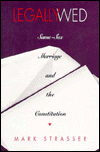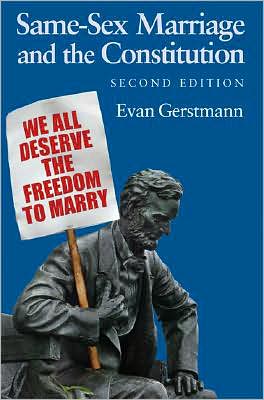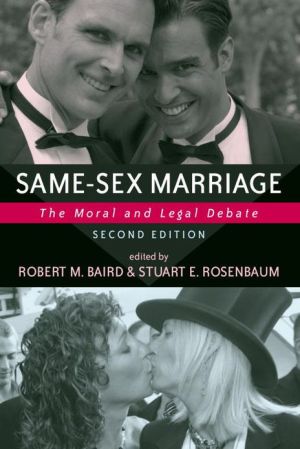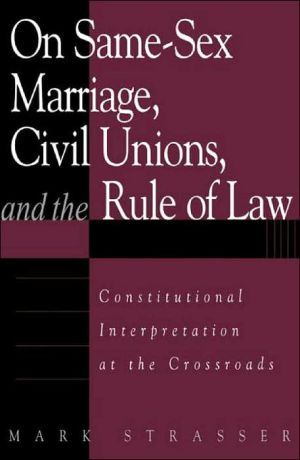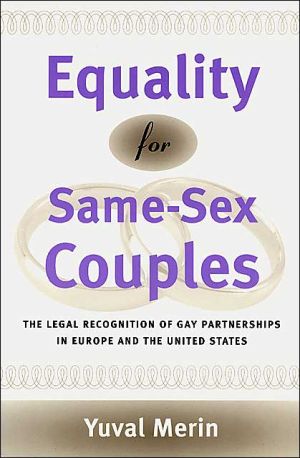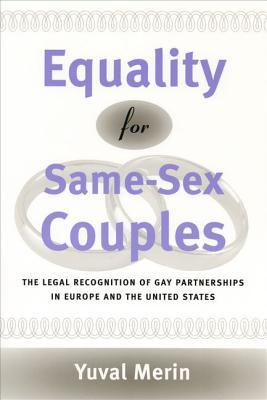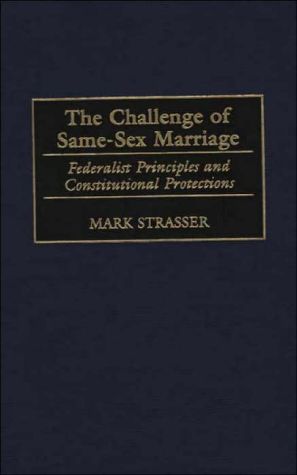Legally Wed: Same-Sex Marriage and the Constitution
Review "Strasser analyzes the arguments against same-sex marriage one by one and concludes that none achieves legal credibility. He reviews the bars on marriage based on definition, procreation, custody, and protection of children and the debates centered on equal protection. Looking at the recently passed Defense of Marriage Act, he concludes that it may be unconstitutional. This book is of great current relevance." ― Library Journal In a new preface, Mark Strasser discusses...
Search in google:
Mark Strasser examines the issue of same-sex marriage in light of contemporary constitutional and domestic relations law, showing why the usual arguments against the state's recognizing such unions are either weak or irrelevant. The Supreme Court has articulated numerous interests promoted by marriage, all of which apply to same-sex as well as opposite-sex couples. According to Strasser, the argument made most frequently to deny recognition to same-sex unions - that marriage exists to provide a setting for the production and raising of children - is in fact a reason to acknowledge such unions. The claim that marriage is for children biologically related to both parents is refuted in the case law, which treats biological and adopted children as legally indistinguishable. Strasser explains Baehr v. Lewin, the precedent-setting case in Hawaii, and addresses the implications of state-by-state decisions to ban or recognize same-sex unions. He analyzes what it would mean to say that a policy violates the Equal Protection or Due Process Clauses of the Constitution, and compares biased policies that target gays and lesbians with those that victimize racial minorities. Strasser argues that the Defense of Marriage Act (DOMA) is both unconstitutional and a public policy disaster. Arguably, it does not give states additional rights with respect to which marriages they need not recognize, but only with respect to which divorces they need not recognize. For example, DOMA seems to allow an individual to avoid a court-imposed duty to support an ex-spouse simply by changing his or her domicile. Moreover, Strasser argues, DOMA is an open invitation for states to demand exceptions that will wreak havoc in domestic relations law. In a reasoned response to conservative arguments about marriage, Legally Wed explicates established and evolving legal principles, and shows how invidiously these have been applied to the issues of gay rights in general and same-sex unions in particular. Library Journal Strasser (law, Capital Univ., Columbus, Ohio) here analyzes the arguments against same-sex marriage one by one and concludes that none achieves legal credibility. He reviews the bars on marriage based on definition, procreation, custody, and protection of children and the debates centered on equal protection. Looking at the recently passed Defense of Marriage Act, he concludes that it may be unconstitutional. The logic of the case presented by Strasser will be debated by lawyers and its success or failure decided by judges in the years to come. As such, this is of great current relevance, but much of the material has already appeared in law reviews, and the legal language may make it more appropriate for special and academic collections. Public libraries should consider Andrew Sullivan's Same-Sex Marriage, Pro and Con (LJ 3/15/97).Jeffery Ingram, Newport P.L., Ore.
AcknowledgmentsIntroduction1IMarriage Barred by Definition5IIEqual Protection23IIIThe Fundamental Interest in Marriage49IVThe Custody and Adoption of Children75VFull Faith And Credit101VIThe Defense of Marriage Act127Notes159Bibliography209Index237
\ Library JournalStrasser (law, Capital Univ., Columbus, Ohio) here analyzes the arguments against same-sex marriage one by one and concludes that none achieves legal credibility. He reviews the bars on marriage based on definition, procreation, custody, and protection of children and the debates centered on equal protection. Looking at the recently passed Defense of Marriage Act, he concludes that it may be unconstitutional. The logic of the case presented by Strasser will be debated by lawyers and its success or failure decided by judges in the years to come. As such, this is of great current relevance, but much of the material has already appeared in law reviews, and the legal language may make it more appropriate for special and academic collections. Public libraries should consider Andrew Sullivan's Same-Sex Marriage, Pro and Con (LJ 3/15/97).Jeffery Ingram, Newport P.L., Ore.\ \ \ \ \ Leslie F. GoldsteinLEGALLY WED takes the form of a series of legal briefs on constitutional and legal questions surrounding the matter of same-sex marriage. The author's two basic arguments, occupying Chapters Two and Three respectively, are (1) that sexual orientation should be treated by courts as a suspect classification under the Fourteenth Amendment equal protection clause and under the equal protection concept believed to be implied (for the federal government) in the Fifth Amendment due process clause (Chapter 2), and (2) that the right to marry whomever one pleases is a fundamental right and as such protected by the U.S. Constitution (Chapter 3). Since either of these arguments, if successful, would trigger the strict scrutiny test against legislative refusals to allow gays to marry each other, and since Strasser is convinced that the promotion of morality cannot count as a compelling governmental interest (p.73), if either of these arguments can succeed, he believes he will have made his case, viz., that it is unconstitutional everywhere in the U. S. for the government to deny anyone the right to marry someone of the same gender. This goal explains why Strasser does not rely on the argument employed in the Hawaii case, BAEHR v. LEVIN (1993). There the Hawaii Supreme Court announced precisely the argument that Phyllis Schafly used to employ to scare people away from ratifying the Equal Rights Amendment: If sex is a suspect classification, as it is under the Hawaii Constitution, which contains its own ERA, then a law that forbids men to do what it permits women to do (namely, marry a woman) can be upheld only on a showing that the law is necessary for attaining a compelling governmental interest. The Hawaii Supreme Court saw no compelling interest in barring same-sex marriage. As I understand it, a state constitutional amendment to ban such marriages is now pending in Hawaii. To the query that may be on some people's minds at this point, "How can it be sex discrimination if BOTH men AND women are forbidden to marry a same-sex partner?" both Strasser and the Hawaii Supreme Court rely on logic prominent in LOVING v. VIRGINIA (1967), the Supreme Court precedent that found race discrimination in state prohibitions of interracial marriage, and on that grounds applied strict scrutiny and struck them down. A better foundation for LOVING was the argument, also present there, that the statute served no real governmental interest other than the maintenance of white supremacy, and this goal is rendered illegitimate by the equal protection clause itself. But Strasser, Schafly, and the Hawaii Supreme Court, are all correct: the U.S. Supreme Court opened itself up for this same-sex marriage line of reasoning with its strict scrutiny argument in LOVING. Of course, maintaining white supremacy could not count as part of public morality after the Fourteenth Amendment was ratified, and on this grounds a ban of same-sex marriage can arguably be distinguished from a ban on interracial marriage. The preservation of the term "marriage" for heterosexual unions is obviously a strongly felt goal of American public morality at this time. This fact was manifest in the wave of recent state laws (echoed by one from the U.S. Congress) adopted to announce that "marriage" can take place only between a man and a woman, in fear that without such laws the Full Faith and Credit Clause (Art. IV, Sec.1) would require states to recognize same-sex marriages legally performed in Hawaii. The clause states: "full faith and credit shall be given in each State to the public acts, records, and judicial proceedings of every other state." Contrary to what the clause SEEMS to say, it turns out that the precedents are quite clear that the clause does not oblige a state to recognize proceedings in other states that are contrary to the state's own public policy (Chapter 5). In short, the gist of the clause is that states are forbidden to refuse to recognize public acts of other states on the sheer ground that they were enacted in other states; it is essentially a prohibition of discrimination against out-of-state proceedings on the grounds of their out-of-stateness. So, when the possibility of legalization of same-sex marriage in Hawaii hit the news, all the states that opposed such marriage immediately had a legal incentive to put on record that these marriages were contrary to their own policy. Chapter Five makes clear that Congress's recent proclamation (the Defense of Marriage Act) that such marriages need not be recognized under Art. IV, Sec. 1 was redundant and of no legal effect. Moreover, Strasser identifies a few arcane divorce law complications that may be caused by this unneeded federal law. The Hawaii development (assuming the state constitutional amendment fails) is a possibility, then, in only those states that do have their own Equal Rights Amendment. This would not satisfy Strasser, who feels that people should be allowed to marry a same sex partner anywhere in the U.S., and hence his arguments in Chapters 2 and 3. He supplements these arguments with an attack on the claims that "marriage" between two persons of the same sex is contrary to the definition of marriage (Chapter 1). Prominent in his attack is the fact that a Virginia Court in 1804 said that the concept of marriage did not include interracial unions. His basic point is that a mere CLAIM of the sort, "We define X as not including Y," is not thereby immune from constitutional scrutiny. Since many people take the purpose of marriage to be the encouragement of unions where children will be produced and nurtured, Strasser devotes a fair amount of space to reviewing and critiquing court practices on child custody and adoption with respect to gay parents (Chapter 4). No reader who has reached this chapter will be surprised to learn that Strasser argues, "Courts should not allow their custodial policies to be determined by private bigotry" (p.88). Indeed they should not, and one hopes they do not. Many gay people are fine parents. This chapter is unexceptionable and contains no major surprises. The core of this book lies in its dual claims that sexual orientation discrimination should be treated as a suspect classification (on the grounds that it shares a number of the traits that the U.S. Supreme Court has said such classifications have), and that freedom to choose one's marriage partner is a fundamental right. Strasser reveals neither patience nor empathy for the fact that intense majorities in many states evidently feel deep moral convictions against linking the word marriage to homosexual unions. Strasser makes much of the analogy to bans on interracial marriage but ignores the special burden that the equal protection clause--because of its historic purpose to raise African-Americans to equal citizenship--placed on such bans. Granted, this meaning of the clause went unacknowledged by court majorities for a century, but that sorry history does not make the fact less true. His argument on same-sex marriage bears no such link to the historic purpose of the Fourteenth Amendment, although he rests his argument entirely on that amendment. Same-sex marriages are much closer in the contemporary public mind to bigamous unions or to brother-sister adult incest than to interracial unions. Strasser never explores the problematic applicability of his arguments to such unions. The absence of such reflection is tied to a basic problem with the book: Despite its interesting subject, it is a remarkably tedious read. It lacks the leavening by humorous anecdotes or corny names in hypotheticals that gifted law professors have learned to throw in, to spice up their dry arguments. It also lacks the thoughtfulness of genuine philosophic reflection that one finds in a book like Judge Richard Posner's SEX AND REASON (Harvard, 1992). Strasser (at least in this book) is much more interested in finding the clincher argument than in exploring such things as the nature of morality or why many profoundly wise persons have believed it appropriate for societies to foster morality.\ \
